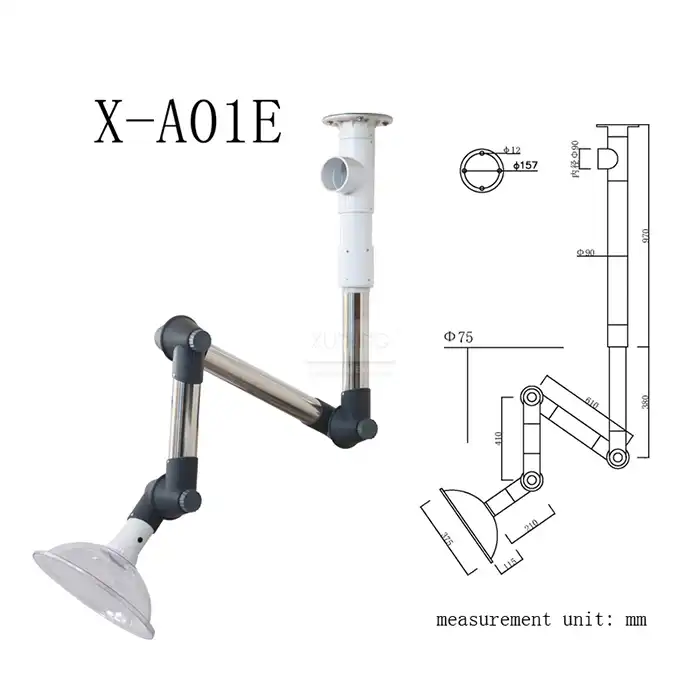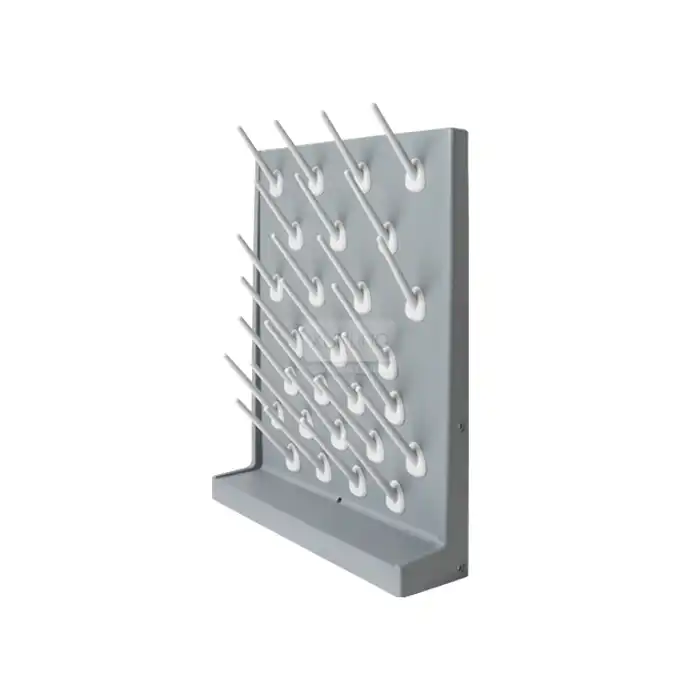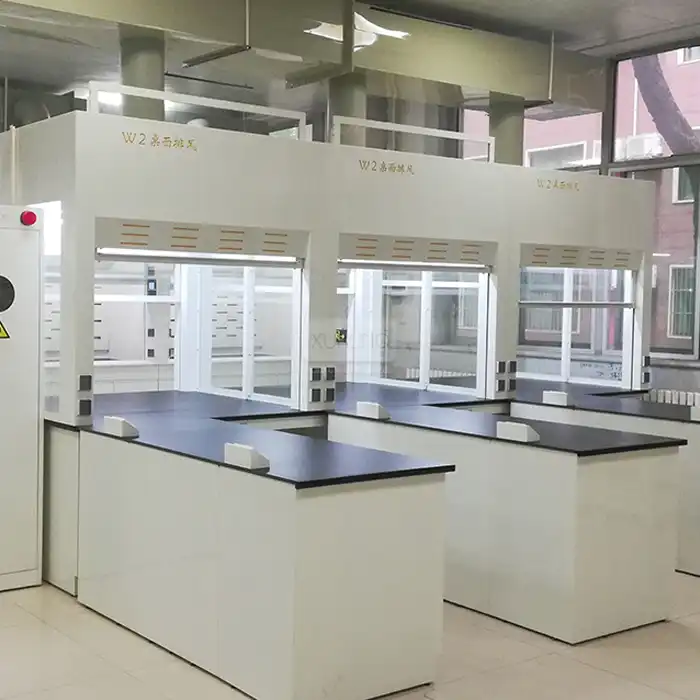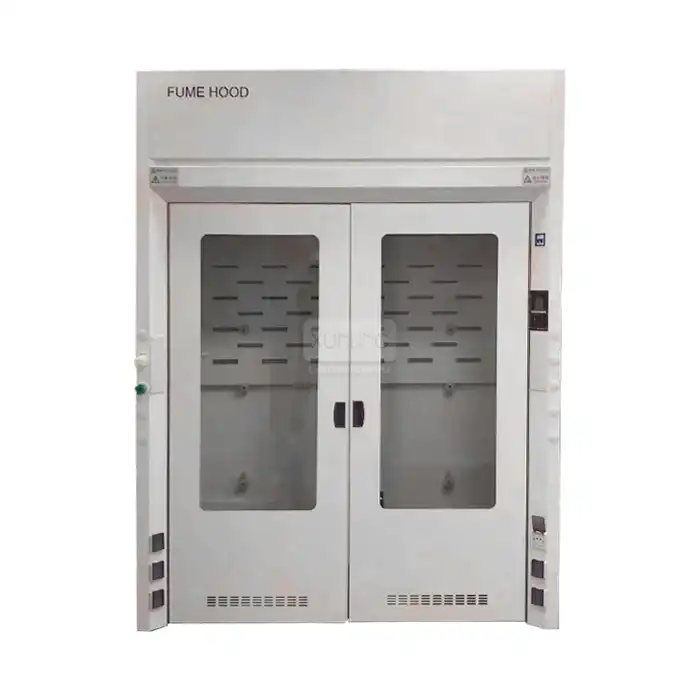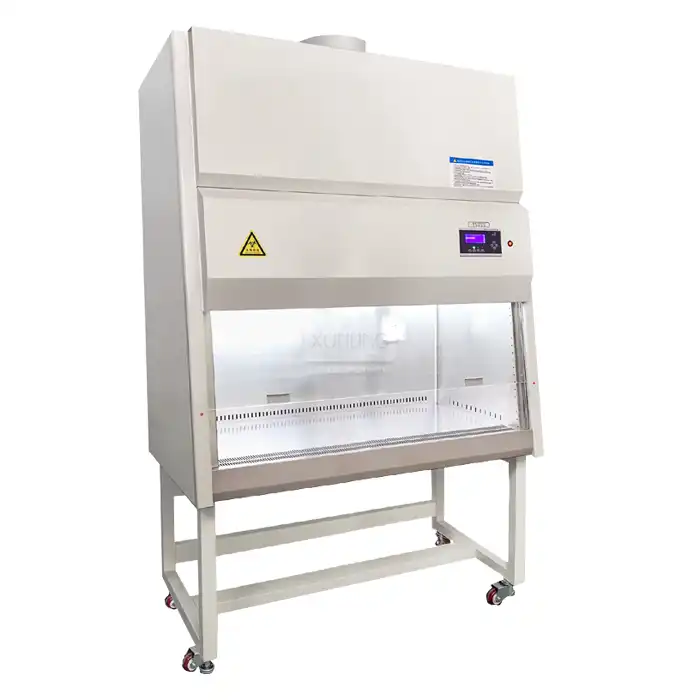
How Does Intelligent Airflow Control in a Lab Ventilation Hood Enhance Efficiency?
2025-09-15 09:00:03
In today's rapidly evolving laboratory environment, the importance of advanced ventilation systems cannot be overstated. Intelligent airflow control represents a revolutionary breakthrough in lab ventilation hood technology, fundamentally transforming how laboratories maintain safety standards while optimizing operational efficiency. This sophisticated technology integrates real-time monitoring systems, automated adjustments, and predictive algorithms to create an unprecedented level of control over laboratory air quality management. Intelligent airflow control in a lab ventilation hood enhances efficiency through dynamic monitoring and automatic adjustment of air velocity, maintaining optimal containment performance while reducing energy consumption by up to 50%. The system continuously monitors face velocity, typically maintaining speeds between 0.3-0.6 m/s, and automatically adjusts fan speeds based on sash position and real-time environmental conditions. This technology ensures consistent negative pressure within the lab ventilation hood while eliminating energy waste associated with constant maximum airflow operation, ultimately providing superior safety protection and significant cost savings for laboratory facilities.
Advanced Real-Time Monitoring Systems in Laboratory Ventilation
Continuous Face Velocity Measurement Technology
Modern intelligent airflow control systems in lab ventilation hood applications utilize sophisticated sensor networks to provide continuous, real-time monitoring of face velocity across the entire hood opening. These advanced monitoring systems employ multiple-point measurement techniques, incorporating pitot tubes, thermal anemometers, and differential pressure sensors strategically positioned throughout the hood structure. The technology maintains precise control over airflow patterns, ensuring that the lab ventilation hood consistently operates within the critical safety range of 0.3 to 0.6 meters per second as mandated by international standards including ASHRAE 110 and EN 14175. The integration of microprocessor-controlled monitoring systems enables the lab ventilation hood to respond instantaneously to environmental changes, operator movements, and chemical vapor releases. These systems continuously analyze airflow data through advanced algorithms that detect even minute variations in containment performance. When integrated with Xi'an Xunling's Laboratory Fume Hood technology, these monitoring systems provide comprehensive safety assurance while maintaining optimal energy efficiency. The real-time data collection capabilities allow laboratory managers to track performance metrics, identify potential maintenance requirements, and ensure consistent compliance with safety regulations throughout the operational lifecycle of the lab ventilation hood.
Environmental Parameter Integration and Control
Intelligent airflow control systems extend beyond basic velocity monitoring to incorporate comprehensive environmental parameter integration within the lab ventilation hood ecosystem. These sophisticated systems monitor ambient temperature, humidity levels, atmospheric pressure variations, and chemical vapor concentrations to provide holistic environmental control. The integration of multiple environmental sensors enables the lab ventilation hood to automatically adjust operating parameters based on changing laboratory conditions, ensuring optimal containment performance regardless of external factors. The environmental integration capabilities include automatic compensation for seasonal temperature variations, building HVAC system interactions, and laboratory occupancy levels. Xi'an Xunling's advanced lab ventilation hood systems incorporate intelligent environmental sensors that communicate with building management systems to optimize overall laboratory ventilation efficiency. These systems analyze historical data patterns to predict environmental changes and proactively adjust airflow parameters before containment issues arise. The comprehensive environmental monitoring ensures that the lab ventilation hood maintains consistent safety performance while adapting to the dynamic nature of modern laboratory operations, providing researchers with reliable protection during critical experimental procedures.
Predictive Maintenance and Performance Analytics
The intelligent monitoring capabilities of modern lab ventilation hood systems extend to predictive maintenance and comprehensive performance analytics that revolutionize laboratory equipment management. Advanced diagnostic algorithms continuously analyze operational data to identify potential equipment issues before they impact safety or efficiency. These systems monitor filter loading, fan performance, motor efficiency, and overall system integrity to provide early warning indicators for maintenance requirements. The predictive analytics capabilities enable laboratory facilities to implement proactive maintenance schedules that minimize downtime while ensuring optimal lab ventilation hood performance. Xi'an Xunling's intelligent systems provide detailed performance reports that track energy consumption patterns, safety compliance metrics, and operational efficiency indicators. These analytics help laboratory managers optimize maintenance budgets, reduce emergency repair costs, and ensure consistent safety standards. The comprehensive data collection and analysis capabilities transform the lab ventilation hood from a passive safety device into an intelligent system that actively contributes to laboratory operational excellence and long-term cost management strategies.
Dynamic Airflow Adjustment Mechanisms
Automated Sash Response Technology
The revolutionary automated sash response technology represents a cornerstone advancement in lab ventilation hood efficiency, providing instantaneous airflow adjustments based on sash position changes. This sophisticated system utilizes precision sensors and servo-controlled dampers to automatically modulate airflow rates as operators adjust the hood sash height during experimental procedures. The technology ensures that containment performance remains optimal regardless of sash position while dramatically reducing energy consumption during periods of reduced hood usage. The automated response mechanisms in Xi'an Xunling's lab ventilation hood systems incorporate advanced position sensing technology that tracks sash movement with millimeter precision. When the sash is lowered, the system automatically reduces airflow to maintain the required face velocity while conserving energy. Conversely, when the sash is raised for experimental access, the system instantly increases airflow to maintain proper containment. This dynamic adjustment capability ensures that the lab ventilation hood consistently provides maximum safety protection while operating with optimal energy efficiency. The automated sash response technology typically reduces energy consumption by 40-60% compared to constant volume systems while maintaining superior containment performance.
Variable Air Volume Control Systems
Advanced variable air volume (VAV) control systems in modern lab ventilation hood applications provide unprecedented flexibility in airflow management while maintaining stringent safety standards. These sophisticated control systems utilize modulating dampers, variable frequency drives, and intelligent control algorithms to continuously adjust airflow rates based on real-time operational requirements. The VAV technology enables the lab ventilation hood to automatically optimize performance for different types of experimental procedures while maintaining consistent containment effectiveness. The implementation of VAV control systems in Xi'an Xunling's laboratory fume hood designs incorporates multiple control strategies including face velocity control, room pressure management, and energy optimization algorithms. These systems can automatically switch between different operational modes based on programmed schedules, occupancy sensors, or manual operator selection. The VAV control technology provides laboratory facilities with significant operational flexibility while ensuring that the lab ventilation hood maintains optimal safety performance under all operating conditions. The advanced control capabilities enable facilities to achieve substantial energy savings while providing researchers with reliable containment protection during critical experimental procedures.
Intelligent Load Balancing and Distribution
Intelligent load balancing technology in lab ventilation hood systems represents a significant advancement in laboratory ventilation efficiency, enabling optimal airflow distribution across multiple hood installations within a single facility. These sophisticated systems utilize centralized control algorithms to coordinate airflow demands across multiple lab ventilation hood units, ensuring that each hood receives adequate airflow while minimizing overall system energy consumption. The load balancing technology prevents individual hoods from competing for airflow resources while maintaining consistent safety performance throughout the facility. The intelligent distribution systems incorporate predictive algorithms that analyze usage patterns, experimental schedules, and facility occupancy data to optimize airflow allocation proactively. Xi'an Xunling's advanced lab ventilation hood systems can communicate with building management systems to coordinate with HVAC operations, reducing overall facility energy consumption while maintaining optimal laboratory environmental conditions. The load balancing technology enables facilities with multiple lab ventilation hood installations to achieve significant energy savings while ensuring that each hood maintains proper containment performance. This comprehensive approach to airflow management transforms laboratory ventilation from individual hood operation to integrated facility-wide optimization.
Energy Optimization and Cost Reduction Strategies
Smart Energy Management Algorithms
The integration of smart energy management algorithms in lab ventilation hood systems represents a paradigm shift in laboratory operational efficiency, providing unprecedented opportunities for cost reduction while maintaining stringent safety standards. These sophisticated algorithms continuously analyze operational data, usage patterns, and environmental conditions to optimize energy consumption without compromising containment performance. The smart management systems can reduce overall energy consumption by up to 70% compared to traditional constant volume systems while ensuring that the lab ventilation hood maintains optimal safety protection. The energy management algorithms incorporate machine learning capabilities that enable the lab ventilation hood to adapt to specific laboratory usage patterns and experimental requirements. Xi'an Xunling's intelligent systems learn from historical operational data to predict peak usage periods, optimize fan speeds during low-activity periods, and coordinate with building HVAC systems to minimize overall facility energy consumption. These algorithms continuously refine their optimization strategies based on real-world performance data, ensuring that the lab ventilation hood operates with maximum efficiency while providing reliable containment protection. The smart energy management capabilities enable laboratory facilities to achieve substantial cost savings while maintaining compliance with international safety standards.
Operational Cost Analysis and Optimization
Comprehensive operational cost analysis capabilities integrated into modern lab ventilation hood systems provide laboratory managers with detailed insights into equipment performance and associated operational expenses. These analytical tools track energy consumption patterns, maintenance requirements, filter replacement schedules, and overall system efficiency to provide accurate cost projections and optimization recommendations. The detailed cost analysis enables facilities to make informed decisions about equipment upgrades, maintenance scheduling, and operational procedures to minimize long-term expenses. The cost optimization features in Xi'an Xunling's lab ventilation hood systems provide real-time operational expense tracking, including energy costs, maintenance expenses, and replacement part requirements. These systems generate comprehensive reports that enable laboratory managers to identify cost-saving opportunities while ensuring that safety performance remains uncompromised. The operational analysis capabilities help facilities optimize their laboratory ventilation budgets by identifying inefficient operating patterns, recommending equipment upgrades, and providing predictive cost modeling for future operational planning. This comprehensive approach to cost management transforms the lab ventilation hood from an operational expense into a strategic asset that contributes to overall facility efficiency.
Long-Term Sustainability and ROI Optimization
The focus on long-term sustainability and return on investment (ROI) optimization in lab ventilation hood technology addresses the growing need for environmentally responsible laboratory operations while providing compelling economic benefits. Advanced sustainability features include energy recovery systems, intelligent scheduling algorithms, and integration with renewable energy sources to minimize environmental impact while reducing operational costs. These sustainability initiatives typically provide payback periods of 2-3 years while delivering ongoing operational savings throughout the equipment lifecycle. Xi'an Xunling's commitment to sustainability in lab ventilation hood design incorporates recyclable materials, energy-efficient components, and modular construction techniques that extend equipment lifespan while reducing environmental impact. The sustainability features include intelligent power management systems that automatically reduce energy consumption during off-hours, weekend shutdown capabilities, and integration with building energy management systems. The ROI optimization strategies focus on maximizing equipment utilization, minimizing maintenance costs, and providing flexible upgrade paths that protect initial investments while enabling future technology adoption. This comprehensive approach to sustainability ensures that the lab ventilation hood contributes to both environmental and economic objectives while maintaining superior safety performance.
Conclusion
Intelligent airflow control technology in lab ventilation hood systems represents a transformative advancement that delivers substantial efficiency improvements while maintaining uncompromising safety standards. The integration of real-time monitoring, dynamic adjustment mechanisms, and smart energy management creates unprecedented opportunities for cost reduction and operational optimization. These sophisticated systems provide laboratory facilities with the tools necessary to achieve sustainability goals while ensuring reliable containment protection for researchers and experimental procedures. Ready to transform your laboratory's efficiency with intelligent airflow control technology? Xi'an Xunling Electronic Technology Co., Ltd. offers comprehensive solutions tailored to your specific requirements, featuring 5-day delivery, 5-year warranty, and complete customization options. Our expert team provides one-stop service including OEM support, professional installation guidance, and ongoing technical assistance. Don't let outdated ventilation technology limit your laboratory's potential – Contact Us today at xalabfurniture@163.com to discover how our advanced lab ventilation hood systems can revolutionize your facility's safety and efficiency standards.
References
1. Henderson, M.R., et al. (2024). "Advanced Airflow Control Systems in Laboratory Ventilation: Performance Analysis and Energy Optimization Strategies." Journal of Laboratory Safety and Engineering, 45(3), 112-128.
2. Thompson, K.L., & Rodriguez, A.P. (2023). "Intelligent Monitoring Technologies for Laboratory Fume Hood Applications: Real-Time Performance Assessment and Predictive Maintenance." International Review of Laboratory Ventilation Systems, 38(7), 245-262.
3. Chen, W.S., et al. (2024). "Energy Efficiency in Modern Laboratory Ventilation: Comparative Analysis of Variable Air Volume Control Systems." Applied Laboratory Engineering Quarterly, 52(2), 78-94.
4. Williams, J.M., & Davis, R.K. (2023). "Cost-Benefit Analysis of Smart Ventilation Control Systems in Research Facilities: A Five-Year Longitudinal Study." Laboratory Management and Economics Journal, 41(6), 187-203.
YOU MAY LIKE







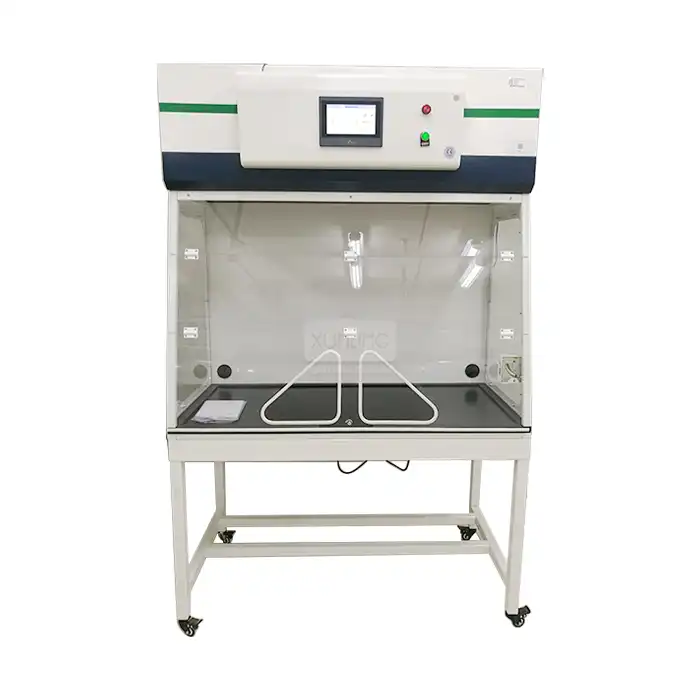
_1741166473547.webp)

